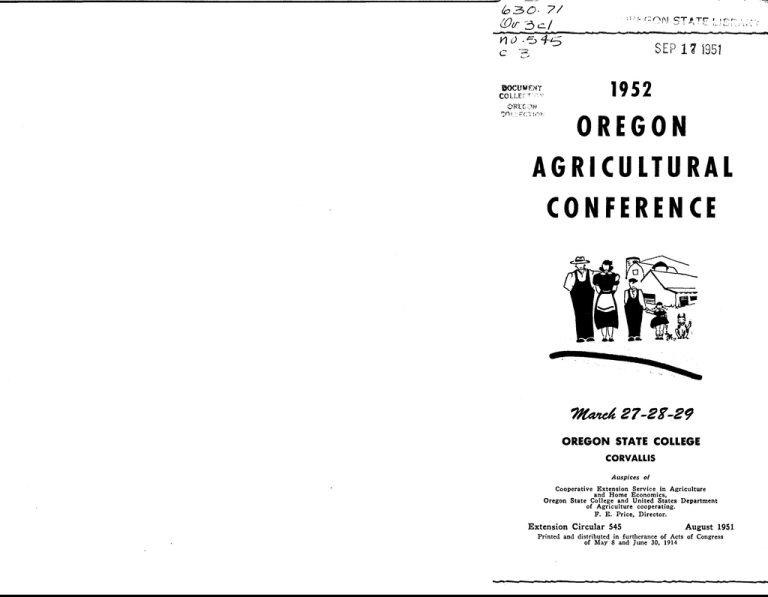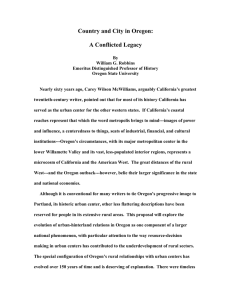T:: AGRICULTURAL OREGON CONFERENCE
advertisement

T:: 7/ 3 / SEP17 1951 ocui COLLEtT' LRX 1 9 5 2 OREGON AGRICULTURAL CONFERENCE 2$tae4 27-2t-29 OREGON STATE COLLEGE CORVALLIS Auspices of Cooperative Extension Service in Agriculture and Home Economics, Oregon State College and United States Department of Agriculture cooperating. P. H. Price, Director. Extension Circular 545 August 1951 Printed and distributed in furtherance of Acts of Congress of May 8 and June 30, 1914 Ted O6/eeeaied '4ae Ta T4 A state-wide meeting of rural and urban people interested in agriculture and rural homes. Committees of farm people, assisted by technical consultants, will present reports giving their views as to the needs and opportunities for development of Oregon agricul- ture and rural living for the next 10 to 25 years. By careful analysis of resources and market outlets to determine what products and marketing methods will insure continued sound economic growth of Oregon's agriculture. Through counseling together of foresighted farmers, homemakers, business and technical people to set up a program of development common good. ward migration has largely changed this. Today California is the best market for many products. The Extension Service began planning for this state-wide conference in the spring of 1950. By fall 11 committees had been decided upon. During the winter of 1950-51, 490 rural people were invited to serve on College staff members were assigned as secretaries. Committee meetings were started in February 1951. These will continue throughout the year and until early 1952 when a preliminary report will be prepared for consideration of the conference in March. Among the many questions to be considered are the following: 1. Should Oregon farms direct producIn 1924 much of Oregon's farm produce had to seek markets on the East Coast. West- 9acae4c these committees. behind which all forces can unite for the Such a conference was held in 1924. The program adopted at that time has played an important part in guiding the development of Oregon's agricultural resources. Ttd tion to Pacific Coast market demands? 2. How can farm forest products achieve a position of importance in the large list of crops? 3. What should be done to translate the economic returns into better rural liv- Consultants from state, federal, and private agencies or organizations have been invited to work with each of the 11 committees. Final consideration of the 11 committee reports will be given at the state-wide conference. Woven together, these will make a statewide program to guide the development of rural Oregon. ing? Great changes in products produced and processed for market have taken place since 1924. Answers are sought for these changing conditions. 4. Are adjustments needed to insure the continued and increased productivity of the soil and water resources? 5. How do changing dietary demands, technological changes and international trade affect long-time production plans? General recognition of the need for wise conservation and use of soil and water resources has been established. This may well be the keystone to future considerations. In short, a program to guide Oregon's rural development for the next 10 to 25 years. ELEVEN COMMITTEES NOW WORKING Secretary Chairman Paulen Kaseberg E. R. Jack*nan Farm Crops Larry Williams H. A. Lindgren Livestock R. W. Morse Dairy S. B. Hall Mrs. Mabel Mack Rural Life L. E. Francis N. L. Bennion Geo. Petersen Poultry Glen Hawkins C. R. Ross Farm Forestry R. E. Dimick Robert Watt Fur Farming Horticulture C. 0. Rawlings Riddell Lage R. R. Clark Mike Dering Specialty Crops Soil and Water Resources Ed McCanse A. S. King Charles A. Tom Land Economics J. C. Moore Committee TeT4j/oei The Extension Service has built its program The 1952 Conference is open to all. of work through consultation with rural committees. Since the state-wide conference of 1924, county economic planning conferences have been held several times in every county. All interested people are invited. In recent years County Agricultural Advisory Councils have been organized and are functioning in every county. These meet two or more times annually to review prog- ress and to adopt new program objectives. These programs are on a county basis. The datesMarch 27-28-29--were chosen be- cause that is spring vacation for Oregon State College students. All facilities of the College and Corvallis will be available. In many county programs there are similar or identical goals. It is felt that greater impetus can be given such programs if they are drawn together as long-time state goals. Details on the Conference are available from County Extension Offices or from Oregon State College. In 1924 Oregon was still largely rural. Many newcomers, coupled with increased industrial development, now have changed the ratio to one which is largely urban. It is estimated that there are half-a-million people now in the state who are unfamiliar with Oregon agriculture. This conference and its reports should be of value to all. The reports of the committees as approved at the Conference will be combined and published for general distribution.



